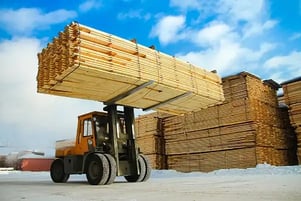The construction industry has faced multiple challenges since the advent of the pandemic. With just a brief pause in early lockdown, the sector was one of the first to return, only to face a series of ultra-thorny issues like stock shortages, record material prices and wide-ranging personnel problems.

Better data provision through sales enablement technology is helping building product manufacturers and distributors tackle those challenges head-on and ready themselves for opportunities in what remains a buoyant market.
Pricing in cost pressures
Rising costs have been the hallmark of the pandemic across many sectors, but especially so in construction, where a lot of mainstay products have been rising in price for months.
“Staying close to customers to understand their needs (is) more important than ever for manufacturers and distributors.”
According to the latest statistics from the Department for Business, Energy and Industrial Strategy (BEIS), steel, timber and concrete prices have all experienced price rises of 30% or more this past year due to a number of converging global factors.
This makes staying close to customers to understand their needs more important than ever for manufacturers and distributors, particularly so when customers are more open than ever to shopping around.
Historic pricing data can prove highly instructive when negotiating new agreements and price adjustments with customers, putting sales teams with access to real-time metrics via a sales enablement solution like sales-i at a significant advantage to their more spreadsheet-driven counterparts.
Taking stock of inventories

Fulfilling customer demand during a period of escalating prices is always a challenge but especially so when many materials are in short supply. From timber to plasterboard, specifiers have had to become accustomed to longer lead times on a variety of everyday construction items this year and with record shipping costs persisting internationally and a shortage of HGV drivers nationally, this situation looks likely to persist over the coming months.
Once again, having comprehensive access to historic customer buying patterns can help merchants and manufacturers make far more educated decisions about likely future stocking requirements and where the biggest pain points are likely to occur and what alternative products customers might be likely to specify if shortages persist.
Prioritizing personnel
The pandemic has created many personnel challenges for employers across the sector. From sourcing skilled labor, managing absences, helping teams get to grips with remote working and retaining and motivating top talent in what has increasingly become a candidate-focussed jobs market.
Technology provision has been essential in helping businesses to mitigate these issues, especially from a business development perspective where sales enablement software has helped teams to keep a strong grip on customer relationships.
What’s more, we’re increasingly seeing strong sales tech provision act as a significant pull factor for candidates when deciding between job opportunities.
The availability of rich data helps new personnel sell and manage customer relationships better from day one, acting as a significant motivational tool to new recruits and their more experienced counterparts alike.
Following the forecast
With supply and demand variables in such a state of flux right now, the importance of forecasting has taken on an added dimension.
All too often building products sales are conducted on a ‘here and now’ transactional basis with scant thought given to longer-term customer requirements and how these might be accommodated. In today’s market, this could mean key customers going elsewhere - potentially for good - if your business is unable to meet their future order demands.
With fractured supply chains still recovering from the impact of the pandemic, working collaboratively with customers to understand and plan for likely future demand is an absolute must. Once again, consulting the data is key to gaining a commercial edge. By reviewing customer purchasing patterns quickly and easily, sales reps can better advise their customers about likely future demand and plan to accommodate their needs for the longer term.
Building back better?
 The UK’s full emergence from lockdown has obviously given the construction sector a boost but with some uncertainty over the potential need for further restrictions over the autumn and winter months, it is likely to be a bumpy road ahead for suppliers to the industry. That said, it’s far from all doom and gloom out there. Just this July, new research from the Construction Products Association indicated the UK construction sector is set to grow by 6.3% next year and 2.7% in 2023 as the economy continues to rebound.
The UK’s full emergence from lockdown has obviously given the construction sector a boost but with some uncertainty over the potential need for further restrictions over the autumn and winter months, it is likely to be a bumpy road ahead for suppliers to the industry. That said, it’s far from all doom and gloom out there. Just this July, new research from the Construction Products Association indicated the UK construction sector is set to grow by 6.3% next year and 2.7% in 2023 as the economy continues to rebound.
Against this backdrop, the most forward-thinking businesses are taking a proactive approach to tackle their thorniest operational challenges now to put themselves in the best position for hopefully more stable conditions to come.
There will of course be winners and losers across the sector as the fallout from the pandemic continues, but for those at the forefront of sales tech adoption, the future rewards as the sector builds back to prosperity promise to be considerable.



